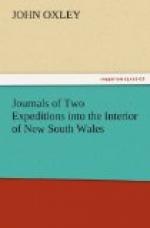September 26.—We proceeded between four and five miles down the river, which was named Hastings River, in honour of the Governor General of India; the vale gradually opening to a greater width between steep and lofty hills, the soil on which was very stony, but rich, and covered with fine grass two or three feet high. At the place where we stopped, small rich flats began to extend on either side, and confirmed our hopes that we should find a more regular country as we approached the sea. The route which we had travelled lay over steep and sharp points of mountains ending on the river, but did not offer any great obstruction. Yet we were obliged to leave the horse which had failed the day before, half-way, as he dropped through utter weakness, though unladen. These valleys and hills are astonishingly rich in timber of various kinds, many new, and their botanic supplies were inexhaustible. Indeed our cargo now principally consists of plants.
September 27.—The morning fine and clear. Sent back for the horse left yesterday, which with some difficulty was brought to the tent. Observed our latitude to be 31. 23. 10. S., longitude by estimation 152. 8. E., variation 8. 22. E. We this day cleaned all the arms, and put our military appointments in order to guard against any hostile attempts that might be made by the natives, who are reported to be in this quarter numerous and treacherous.
September 28.—As we proceeded down the river, the vale still continued to open on either hand, the hills receding from each bank of the stream from two to three miles. The land on the more elevated spots, and irregular low hills, was strong but of good soil, covered with grass: the flats which occurred alternately on both sides of the river were very rich, the grass long and coarse; the timber, blue gum and apple tree. As the points of the higher hills sometimes closed on the river, we found it convenient to cross it, which in the course of the day we did no less than three times. In the hollows of the higher hills were thick brushes of the same description as those at the Five Islands. About six miles and a half down the river it was joined by a considerable stream from the northward, running through a fine and spacious valley. The accession of this water materially altered the appearance of the river, as it began to form long and wide reaches, with alternate rapids over a shingly bottom. The northern stream was named Forbes’s River, in honour of the Marquis of Hastings’ nephew. Although our proximity to the sea seemed to preclude the probability of Hastings River being joined by any other considerable waters; yet its present size made us a little anxious to find that it had a serviceable discharge into the ocean. The ground over which we travelled being very favourable to the weak state of the horses, we accomplished between eight and nine miles. Kangaroos abounded; four were this day killed. Marks of flood were observed to the height of sixteen feet, but the river appeared now to be in its lowest state, and the sides of the barren mountains showed that there had been no rain of any consequence for a considerable time.




